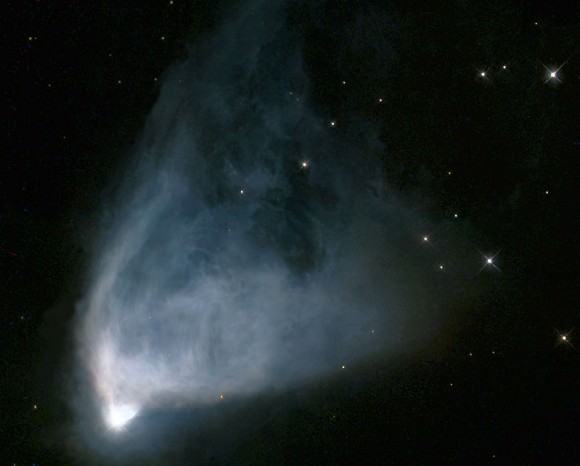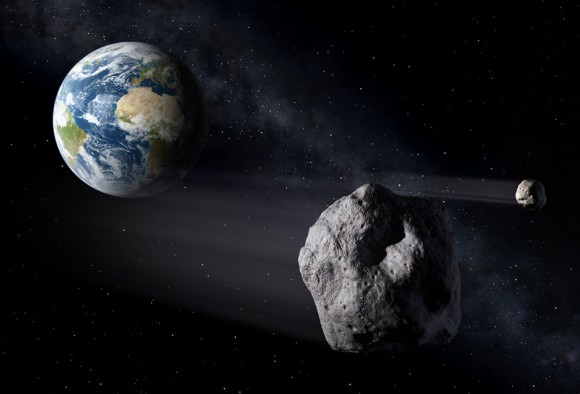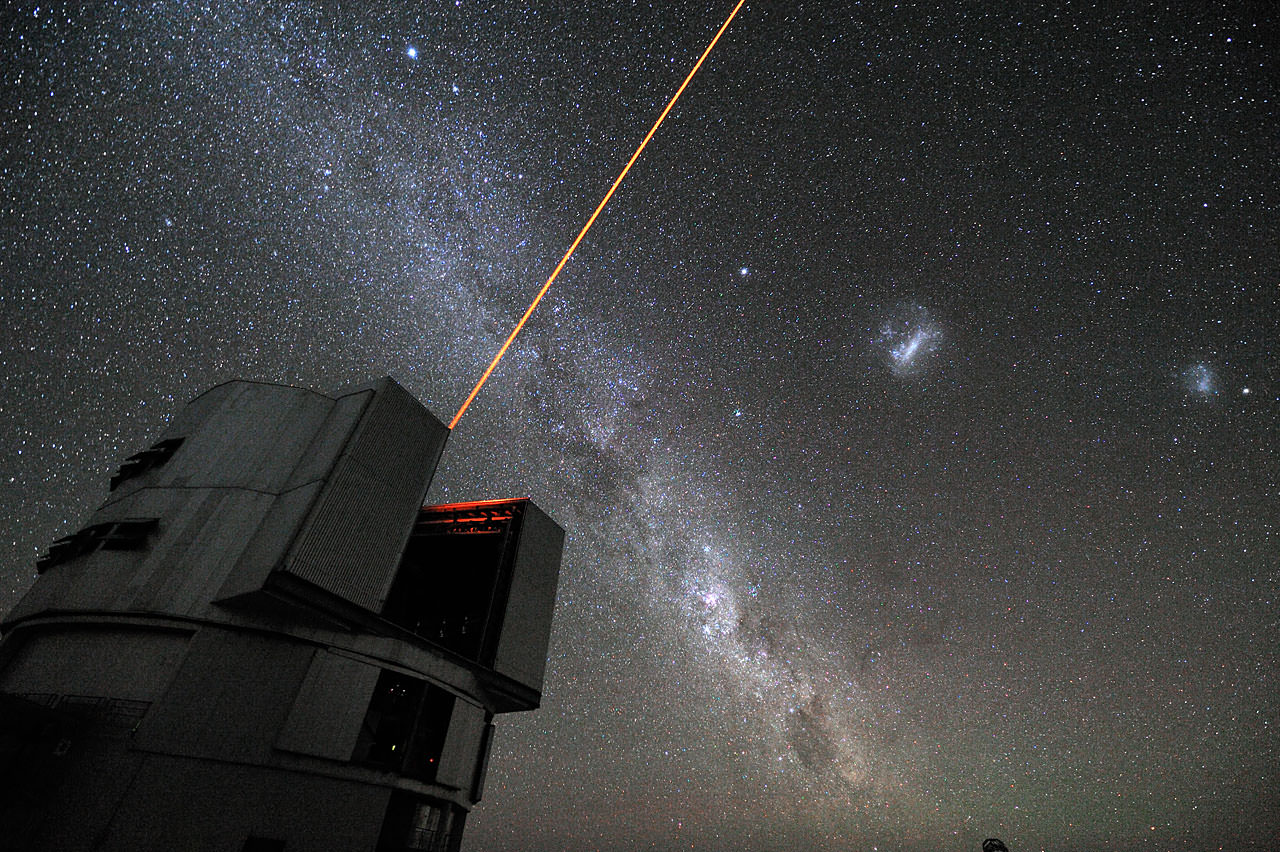It’s a cornerstone of modern physics that nothing in the Universe is faster than the speed of light (c). However, Einstein’s theory of special relativity does allow for instances where certain influences appear to travel faster than light without violating causality. These are what is known as “photonic booms,” a concept similar to a sonic boom, where spots of light are made to move faster than c.
And according to a new study by Robert Nemiroff, a physics professor at Michigan Technological University (and co-creator of Astronomy Picture of the Day), this phenomena may help shine a light (no pun!) on the cosmos, helping us to map it with greater efficiency.
Consider the following scenario: if a laser is swept across a distant object – in this case, the Moon – the spot of laser light will move across the object at a speed greater than c. Basically, the collection of photons are accelerated past the speed of light as the spot traverses both the surface and depth of the object.
The resulting “photonic boom” occurs in the form of a flash, which is seen by the observer when the speed of the light drops from superluminal to below the speed of light. It is made possible by the fact that the spots contain no mass, thereby not violating the fundamental laws of Special Relativity.

Another example occurs regularly in nature, where beams of light from a pulsar sweep across clouds of space-borne dust, creating a spherical shell of light and radiation that expands faster than c when it intersects a surface. Much the same is true of fast-moving shadows, where the speed can be much faster and not restricted to the speed of light if the surface is angular.
At a meeting of the American Astronomical Society in Seattle, Washington earlier this month, Nemiroff shared how these effects could be used to study the universe.
“Photonic booms happen around us quite frequently,” said Nemiroff in a press release, “but they are always too brief to notice. Out in the cosmos they last long enough to notice — but nobody has thought to look for them!”
Superluminal sweeps, he claims, could be used to reveal information on the 3-dimensional geometry and distance of stellar bodies like nearby planets, passing asteroids, and distant objects illuminated by pulsars. The key is finding ways to generate them or observe them accurately.
For the purposes of his study, Nemiroff considered two example scenarios. The first involved a beam being swept across a scattering spherical object – i.e. spots of light moving across the Moon and pulsar companions. In the second, the beam is swept across a “scattering planar wall or linear filament” – in this case, Hubble’s Variable Nebula.

In the former case, asteroids could be mapped out in detail using a laser beam and a telescope equipped with a high-speed camera. The laser could be swept across the surface thousands of times a second and the flashes recorded. In the latter, shadows are observed passing between the bright star R Monocerotis and reflecting dust, at speeds so great that they create photonic booms that are visible for days or weeks.
This sort of imaging technique is fundamentally different from direct observations (which relies on lens photography), radar, and conventional lidar. It is also distinct from Cherenkov radiation – electromagnetic radiation emitted when charged particles pass through a medium at a speed greater than the speed of light in that medium. A case in point is the blue glow emitted by an underwater nuclear reactor.
Combined with the other approaches, it could allow scientists to gain a more complete picture of objects in our Solar System, and even distant cosmological bodies.
Nemiroff’s study accepted for publication by the Publications of the Astronomical Society of Australia, with a preliminary version available online at arXiv Astrophysics
Further reading:
Michigan Tech press release
Robert Nemiroff/Michigan Tech


It’s a cornerstone of modern physics that nothing in the Universe is faster than the speed of light (c). However, Einstein’s theory of special relativity does allow for instances where certain influences appear to travel faster than light without violating causality.
[…]
Consider the following scenario: if a laser is swept across a distant object – in this case, the Moon – the spot of laser light will move across the object at a speed greater than c. Basically, the collection of photons are accelerated past the speed of light as the spot traverses both the surface and depth of the object.
Which part of the first quote did you fail to understand?
No, photons are not accelerated past c in this scenario. In fact, nothing is accelerated, and no photon moves faster than c.
What does move faster than c is the place where the photons hit the object … which is not itself a thing, and does not carry any information (or anything else) along its path, and thus is not bound by the rule in the first paragraph.
[…]when the speed of the light drops from superluminal to below the speed of light[…]
This is beyond absurd.
khms, I fully agree with your critique and I think Mr. Williams
has misinterpreted a great deal.
Consider light from a distant source arriving at a planar surface that is close to perpendicular, but not quite perpendicular, to a line extending from the source. The edge of the planar surface that is closest to the source will be illuminated first with the illumination spreading rapidly from that point of first contact (of the illuminating light) along the surface. It is the spread of the illumination that will appear to an observer to be moving at greater than the speed of light. This is the phenomenon that gives rise to the appearance of superluminal motion.
It is NOT photons moving at superluminal speed! It IS simple geometry.
However, the angle from perpendicular must be very small OR the observer must be very distant – we’re talking hundreds of light years at the very least, for this phenomenon to be sensibly perceived.
Photonic boom?
Light flash?
Neither, by the definition I have provided.
Neither as well by the explanation Mr. Williams has provided. If such are happening we need a much more careful and definitive explanation.
Respectfully,
Hard to make sense of at first glance. But it appears to depend on the same kind of projection effects that really do make some AGN jets look superluminal. I wouldn’t dismiss it out of hand.
Photonic booms / light flashes *do* occur when objects are travelling faster than light in the local medium. That’s what Cherenkov radiation is, typically seen in nuclear reactions. That has nothing to do with the article though. “khms” handled those problems just fine.
I am not well educated in physics, but the “apparent” phenomenon of a laser pointer moving faster than the speed of light over the surface of the moon was one of the prime examples of misconceptions of light in my first, basic physics course taken:
Just imagine light in the form of particles. As the laser pointer sweeps across the moons surface, they hit the surface of the moon one after one, in a line. From a distance it may “look” like a single dot is moving faster then the speed of light, if we calculate its velocity by dividing the distance it crossed by the time it took to do that. But if we look closely, we see gaps in between the individual photons that were reflected off the surface of the moon. The reflection of the laser on the surface of the moon is not a continuous, and secondly it is not even one single particle that is “moving” there, but rather billions of particles (photons) that are reflected and form a dotted line, of which each and every one neatly adhere to the speed of light. This phenomenon does not violate the ultimate speed limit in the universe, and there is not laser, which can move faster than the speed of light!
Therefore I would agree with the previous commentators that the title of this article was poorly chosen and is misleading.
Sincerely.
It’s a sad fact that a number of UT writers seem to have too little of a science background for the job.
To Matt’s defense, this topic is arduous and I certainly don’t understand it myself. At least the Arxiv abstract gives a tentative hint of what it’s really about.
Looks like the author is trying to get a jump on April Fool’s day rush….I guess since the sun rotates ~1,200mph all the sunlight hitting the Earth must be going faster than c as well, no?
When beautifyig ones job fails.
The dude just wants to flash a laser on objects and do a luminosity check along the path of illumination.
If he had stayed away from the terms Superluminal and Photonic booms …. than we would have an article were camera sensitivity has come to the point where small deviations in luminosity are a useful tool to measure things. …. like spotting exo-planets for example.
But for that, all you need is a fixed speed of the illuminated path that is fast enough to negate any rotation of the object you want to measure its surface map from. ….
If that might as well seem to be looking like a dot moving at superluminal speed … that is just something you don’t focus on to much.
How interesting!
Lasers seem impressive in it’s efficiency in calculating the position of distant object but can it make a ship travel faster than (c).
Can anyone say “light echo” ?
http://phys.org/tags/light+echo/
To me the concept seems absurd when you use a hose analogy. If you spray water from a hose to a spot 10′ away, then quickly turn around so you’re spraying in the opposite direction, the water doesn’t suddenly travel any faster as you turn–it just spreads out the impact on the ground during the turn.
I had similar misgivings about this article but he does say early on “However, Einstein’s theory of special relativity does allow for instances where certain influences APPEAR to travel faster than light without violating causality”. If you miss that word “APPEAR” it seems he is misinterpreting some basic concepts about special reativity and apparent velocity. The article needs to be rewritten in my opinion